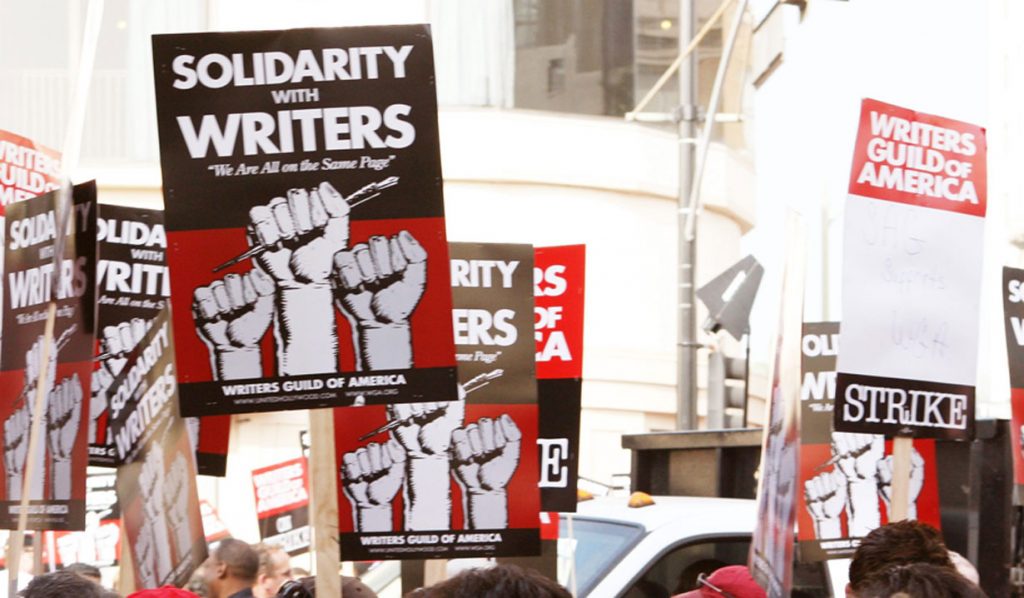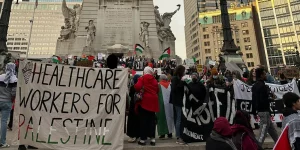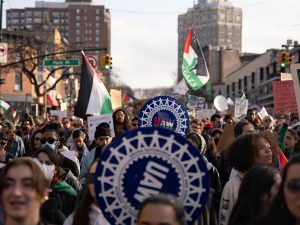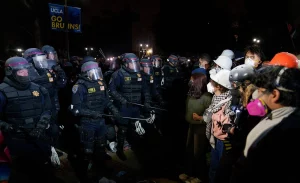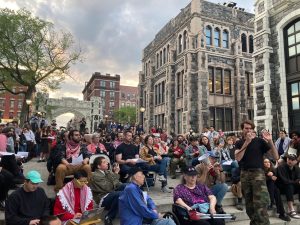The International Association of Theatrical Stage Employees (IATSE)’s struggle for a more equitable contract shares many similarities with the 2007 Writers Guild of America (WGA) strike — including the central antagonist. The Alliance of Motion Picture and Television Producers (AMPTP), which represents the studios that produce TV shows and films, initially offered both unions exploitative contracts that failed to address the unions’ central demands. While the IATSE union bureaucracy caved and accepted a tentative agreement, the WGA went on strike for 100 days in 2007–2008, a move that ultimately halted production on several TV shows, cancelled the Golden Globes, and cost the studios an estimated $2.1 billion in lost revenue.
The WGA strike offers a blueprint for what another entertainment industry strike might look like — and how to win.
The Strike
On November 5, 2007, the WGA, which represents film and television writers, began a strike after negotiations on a new contract with the AMPTP (Alliance of Motion Picture and Television Producers) reached a standstill. Neither side was willing to budge on several key issues, including a proposal to double writers’ residual rates on DVD sales and covering animation and reality TV writers under the WGA’s Minimum Basic Agreement (MBA). But the main point of contention was what was then classified as “new media” — content accessed through the internet and other streaming models. Under the contract at the time, writers received the same residual rate for downloaded movies as for DVDs sold — about 0.3 percent. Streaming, though, was classified as “promotional use,” which meant writers made nothing when their work was accessed online or through video-on-demand services such as TiVo.
AMPTP argued that online markets were untested and needed to be studied before determining a compensation plan. “Their point of view was, ‘We don’t know what [the internet] is yet,” WGA board member David A. Goodman told The Hollywood Reporter in a 2018 article about the strike. “But Hulu went live [a month after] the strike ended. They knew where the business was going.”
Entertainment companies had used similar logic in 1985 contract negotiations. Then, home video was the “untested market” — primarily meaning VHS tapes, which AMPTP argued were expensive to produce. WGA went on strike for two weeks before eventually accepting a proposal that gave writers that 0.3 percent residual rate. As the manufacturing cost of VHS tapes dropped and DVDs — which held the same classification in the WGA contract — eventually cornered the market and became the studios’ largest source of revenue, writers began to feel they had been shortchanged.
Going into negotiations for its 2007 contract, WGA understood that today’s “untested market” is tomorrow’s arena for exploitation. The union was unwilling to accept a contract that did not fairly compensate members for digital distribution of their work. After negotiations with AMPTP stalled over that issue, more than 10,000 writers went on strike for 100 days. It was a huge financial blow to the studios.
WGA Tactics
The WGA understood, as the history of labor struggle has proven, that strikes succeed when the bosses cannot keep work going. So, the union reached out to other unions to help shut down production, encouraging their members not to show up for work on film sets. Many members of the Teamsters union, which represents truck drivers, location managers, and other logistical workers vital to film shoots, refused to cross WGA picket lines. Members of the Screen Actors Guild (SAG) showed their support, too, marching alongside writers or participating in “Speechless Without Writers,” a series of short PSAs organized by WGA members — like the one below with actors Justine Bateman and Jason Bateman.
SAG’s contract with AMPTP and that of its sister union the American Federation of Television and Radio Artists (AFTRA) both had “no strike” clauses, which forbade members from striking in support of other unions. For most union workers, “no strike” clauses strike a real blow against the power of workers when they strike, because the “illegality” typically has instant, and detrimental, financial consequences for individual workers and their families. Many SAG members, however, are celebrities with significant job security, and several actors violated their contracts and refused to work during the strike. Steve Carrell reportedly called in sick with a case of “enlarged balls” and then walked a WGA picket line. Without its lead actor, NBC was forced to halt production on The Office.
Later, when both striking writers and featured celebrities announced they would not attend the 2008 Golden Globes awards ceremony, the event was cancelled. “Once the actors joined the strike and would not cross the picket line, there was no choice for us,” Jorce Camera, then president of the Hollywood Foreign Press Association (which issues the awards), told the Hollywood Reporter. The usual big-budget awards show broadcast on television was downgraded to a press conference. The Los Angeles economy lost $60 million worth of business from the show’s cancellation.
In addition, WGA leveraged the highly visible nature of its industry and appealed directly to the general public. Writers made blogs and videos explaining the issues underpinning the strike, as used more unorthodox and theatrical propaganda, too — such as inviting people to a mock exorcism aimed at Warner Bros. WGA also asked people to mail pencils to the CEOs of CBS, NBC, Fox, and other media conglomerates to show support for the strike. Fans of popular TV shows such as Xena: Warrior Princess even walked picket lines.
Trying to Bust the Union
AMPTP’s response to all this was an attempt to bust the union. And producers went after writers’ relationships with other industry professionals, painting WGA as villains unconcerned with the effects of the strike on other people.
“The below-the-line workers whose families depend entirely on our industry have already lost more than $200 million in the Los Angeles area alone, and the health care benefits for many of these families are now in real jeopardy because of the WGA strike,” the AMPTP wrote in an open letter on Dec. 17, 2007. “The WGA’s organizers refused to engage in early bargaining and then started this strike, and their subsequent negotiating tactics have ensured that the hardships suffering [sic] by below-the-line workers and their families will continue to worsen.”
The bosses also spent hundreds of thousands of dollars on Steve Schmidt, a public relations professional who the next year was John McCain’s presidential election campaign manager, and on the crisis management firm Fabiani & Lehane.
“The AMPTP could stop [the strike] tomorrow because our proposals are affordable and reasonable,” wrote the WGA in a blog post response. “But instead of making a fair deal with us, they hire Fabiani & Lehane.” In a show of solidarity, several Fabiani & Lehane clients, including a Service Employees International Union (SEIU) local and the union coalition Change to Win, broke with the firm.
“By the end of the week, I believe Chris Lehane will have no union clients because of his work for the AMPTP,” SEIU Andy Stern said. “His days are numbered in the labor movement.”
In December 2007, WGA and AMPTP resumed contract talks. This time, AMPTP walked out before a deal was reached, citing the WGA’s inability to compromise on its core demands. Many bloggers and other industry insiders speculated this move was an intentional delay so studios could end several writer-producer deals using force majeure, a clause that allows a party to break a contract in the wake of an unforeseeable event. And on January 14, 2008, AMPTP did just that, nixing 40 deals.
Meanwhile, AMPTP began negotiations on a new contract with the Directors Guild of America (DGA), which had delayed their start in solidarity with the WGA strike. The parties quickly reached a tentative agreement, on January 17. Morale among WGA rank-and-file members, already low after AMPTP successfully axed so many writer-producer deals, dropped even more in response to DGA striking a deal while writers remained on strike.
“That was a low point,” then WGA East president Michael Winship told the Hollywood Reporter. “God bless [the DGA], they got a deal, but we felt strongly that they fell on our backs.”
WGA members pushed for an end to the strike. The union returned to negotiations with the AMPTP and eventually reached an agreement on February 12, 2008.
A New Contract
WGA successfully negotiated a new deal that gave writers a 2 percent residual rate for movies and TV shows accessed via streaming after an initial 17-day window, and a higher overall residual rate for downloads. While more than 90 percent of writers voted to approve the three-year contract, response was mixed. The WGA won a coveted piece of new media profit, but many writers noted that the 17-day window was when their work was most likely to be accessed. In addition, WGA ended up dropping its other two key issues: reality TV and animation continued to be excluded from the WGA’s MBA, and writers kept the same rate for DVD residuals.
Ultimately, the strength of the WGA strike was highest when the union was working in tandem with other unions to stop production. Writers smartly recognized the interconnected nature of Hollywood and worked to show how a win for writers was a win for entertainment workers overall, as the video below explains regarding the residuals issue (and even mentions IATSE).
As one might expect from a writers’ strike, union members knew the value of propaganda. Blog posts kept members up to date on strike news, broke AMPTP tactics down for members, and positioned the 2007 strike within the larger history of labor rights in Hollywood. Online videos leveraged celebrity connections to explain the strike to the general public. Comedy shows such as Saturday Night Live and 30 Rock staged versions of their shows at the UCB improv theater to raise money to pay crew members while the shows remained off the air.
The propaganda campaign did an excellent job of contextualizing the strike. Union writers frequently showed that the strike came down to all entertainment workers — not just WGA members —versus the greed of media moguls. And while WGA didn’t win all of its initial demands, the strike effectively demonstrated what a “United Hollywood” could do. Some 12,000 WGA members succeeded in shutting down production on several shows and costing the studios more than $2 billion in lost revenue.
Today, in 2021, when streaming threatens to replace cable and networks as the dominant ways people watch television programming, the importance of the WGA winning a piece of new media is clear.
Lessons for IATSE
As IATSE members consider whether to vote yes or no on the tentative agreement their leadership struck with the AMPTP — an agreement that addresses none of the rank-and-file members’ key demands — they should keep the 2007 writers’ strike in mind. Workers don’t have to vote yes; IATSE has the same powerful tool in its arsenal that WGA used to force AMPTP to surrender a piece of new media revenue to workers in 2007: the strike. A IATSE strike, particularly one organized around solidarity from other unions, could force AMPTP to offer IATSE members a more equitable contract and remind the bosses that workers are the ones who actually keep Hollywood running.


